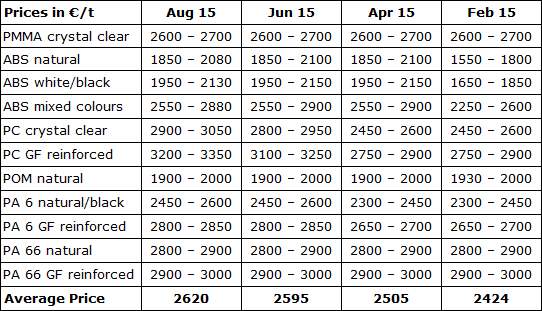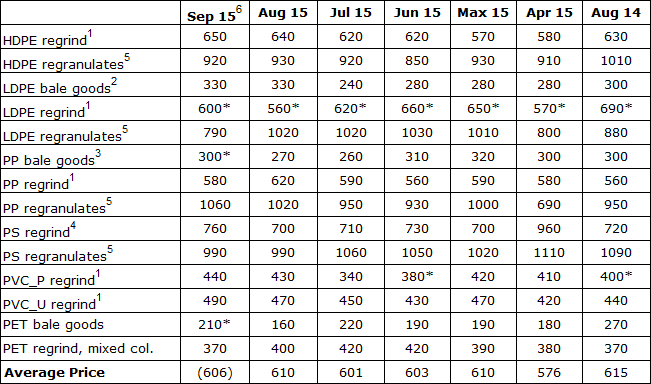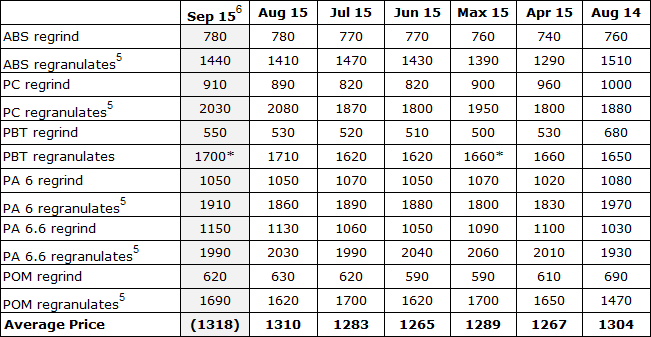Market Report Plastics - September 2015
Information about the market for plastics is being presented by:
bvse - Bundesverband Sekundärrohstoffe und Entsorgung e.V.
1. The market for primary plastics
The plastics industry, consisting of producers, processors and mechanical engineering companies in the plastics sector, supplies the building and construction industry, the food sector, the automotive and electrical industries as well as the mechanical engineering and chemical sectors in particular. Economically, the German plastics industry, with its roughly six per cent share in German industrial production, is a vital industrial sector. In 2014, around 377,000 people found a job with good future prospects in 3,320 companies, achieving a turnover of around 93 billion euros.
In the second quarter, there was an increase in the amount of primary plastics production. The adjusted production index rose by 1.1 % compared to the previous quarter. However, it fell by 0.6 % compared to last year. The trend analysis shows that the amount of plastics materials produced rose by 0.6 % relative to the previous period. In addition, production increased compared to last year. During the summer months, the mechanical engineering sector recorded a 0.9 % fall in production compared to the first quarter of 2015. However, the level attained in the second quarter of 2014 was exceeded by 4.3 %.
1.1 Standard plastics: We can now confirm last month’s question of whether a turnaround is in sight. The average price of standard plastics fell by 70 €/t in August, cf. Table 1. This is explained by restrained demand, which is due to the holiday season, on the one hand, and caution in purchasing, on the other. This caution, for its part, is caused by speculation on a further fall in prices. The low oil price, which entails favourable precursor prices, also contributes to these price cuts. The mineral oil price has averaged US-$ 52.10 over the past 100 days. Depending on the weather, demand for fuel oil will rise in the winter months. However, cold spells often do not occur until February.
There are particularly significant price falls in polyolefins, which average 90 €/t. However, HDPE and LDPE are still in short supply. The price of packaging PET, too, has fallen relatively markedly. It has gone down by 85 €/t compared to the previous month, now averaging 1170 €/t. However, experts point out that demand for standard plastics will rise considerably in the fourth quarter. For a detailed discussion, including details of price indices for virgin materials, waste plastics and precursors, please refer to EUWID Recycling und Entsorgung (EUWID Recycling and Waste Management) or EUWID Kunststoff (EUWID Plastics), cf. www.euwid.de, and KI-Kunststoffinformation (KI Plastics Information), cf. www.kiweb.de.
Table 1: Standard plastics prices according to EUWID over the past five months, listed in €/t.

1.2 Technical plastics: In August technical plastics prices rose only slightly by an average 25 €/t. This indicates price stability. ABS listings fell by an average 20 €/t, the prices achieved by PC rose by an average 100 €/t. PMMA, POM and PA held their own. The number of purchase orders is expected to rise after the summer break. Experts expect prices to remain stable or rise slightly over the next two months.
Table 2: EUWID quotes for technical plastics, which are published every two months, over the past six months, prices in €/t.

2. The market for secondary plastics
Plastics recyclers should be happy because the prices of the processing input they receive from the post-user area are falling. While plasticker largely indicates price stability for bale goods, regrind and regranulates, the listings for post-user PE and post-industrial PP have fallen by an average 30 €/t or 9 €/t. In other words, bale good prices have gone down in EUWID, while regrind listings have remained largely stable.
Waste plastics: During the summer months of August and September, demand for used plastics has been seasonally low. Recyclers are well supplied with processing materials. In addition, stagnating demand from the Far East has led to a fall in processing input prices. Only high-quality goods can still be exported to the Far East – however, this entails considerable price cuts. Experts expect demand from the Far East to be low in September and October, too. Thus, plastics prices are likely to fall once again.
Recyclates: There is still considerable demand for recyclates. Recyclate prices, including regrind, regranulates, regenerates/compounds and agglomerates/compactates, have held their own. Recyclates from PE and PP in particular are in considerable demand. Recyclates from technical plastics are selling well, too. Technical plastics prices have gone up slightly in the areas of primary materials and recyclates. Demand for technical plastics will rise after the summer break.
2.1 EUWID Price Watch
The EUWID Price Watch indicates considerable price reductions in post-user PE and post-industrial PP. However, post-industrial PE, PVC and PS have held their own.
The prices of the following post-user PE grades have fallen: LDPE shrink film natural (E 40) 520-560 €/t, LDPE shrink film mixed colours (E 49) 230-310 €/t, film transparent natural <70 m 360-400 €/t, film transparent mixed colours <70 m 20-150 €/t, LDPE farm film black/white >70 m 40-90 €/t, mixed film (80:20) 180-240 €/t, mixed film (90:10) 230-270 €/t, HDPE hollow bodies mixed colours (C29) 230-350 €/t, HDPE regrind from crates, colours-separated 680-820 €/t and HDPE regrind from crates, mixed colours 550-650 €/t.
Post-industrial PP continues to be in high demand. The prices of bale goods and some types of regrind have fallen slightly: film mixed colours (K59) 130-240 €/t, film natural (K50) 330-480 €/t, homopolymer mixed colours 500-670 €/t, homopolymer natural 680 – 850 €/t, copolymer mixed colours 500-670 €/t and copolymer natural 680-850 €/t. Plastics recyclers are setting their hopes on a further fall in processing input prices.
The PVC listings have, once again, remained unchanged. To date, the price falls from the primary markets have not had any impact on post-industrial PVC. In the summer months, too, the developments in the building and construction sector have been responsible for considerable and stable demand for PVC. PS has benefited from the building boom, too. To date, the price falls from the primary market have not affected post-industrial PS.
The PET recyclers‘ warehouses are replete with stocks. PET recyclers point out that they have stored enough processing input for up to two months. The considerable supply of used and disposable PET bottles has led to further price reductions. Sales of used PET beverage bottles to the Far East are stagnating. The EUWID listings for PET beverage bottles have fallen by 20 €/t each for PET transparent and PET coloured.
2.2 plasticker price index
The plasticker internet platform publishes quotes on an hourly basis. The present market report indicates the final monthly prices. It is only possible to represent the preliminary prices for September 2015. These listings thus merely reflect an interim situation that does not become definitive until October 2015. Plasticker offers the quality grades regrind and regranulates both as virgin materials and as secondary goods. The term ‘bale goods’ refers to waste plastics only.
Standard plastics
In August, standard plastics prices in plasticker averaged 610 €/t. This shows that prices had risen only slightly – by 9 €/t – compared to the previous month. The comparison with last year’s prices, which amounted to 615 €/t, shows that there is still scope for improvement. Some listings for individual quality grades rose by 10 €/t to 90 €/t, while others fell by 10 €/t to 70 €/t. In August there was restrained demand for standard plastics. LDPE regranulate prices have reached record highs since May. PP regrind and PP regranulate prices have risen; PP regranulates broke the 1000 €/t mark in August. PET bale goods mixed colours have reached their lowest level in five years. PS can currently be purchased at favourable prices.
The first preview of the September listings, which cannot be definitively reported until the beginning of October, shows the prospective average price to be 606 €/t. Thus, the plasticker internet platform temporarily indicated on 15 September 2015 that prices had remained unchanged. PP regranulates and PVC continue to be quoted at high prices. To date, demand for standard plastics has been restrained in September.
Table 3: Standard plastics prices according to plasticker, listed in €/t.

*: Supply figures too low to attain statistical significance; 1: equivalent to the grade “post-industrial, mixed colours”; 2: equivalent to K49; 3: equivalent to K59; 4: equivalent to “standard, mixed colours”; 5: equivalent to the grade “regranulates, black”, 6: preview (may be amended by additional quotes)
Technical plastics
In August the average prices of technical plastics were quoted at 1310 €/t in plasticker, i.e. they had increased by 27 €/t compared to the previous month. Compared to last year, technical plastics held their own in August 2015. There were considerable price changes in the individual quality grades: price rises ranged from 10 €/t to 210 €/t and price falls from 20 €/t to 80 €/t. In August demand for technical plastics continued to be considerable. PC regranulate prices soared by 210 €/t and PBT regranulates by 90 €/t.
The first preview of the September listings, which cannot be definitively reported until the beginning of October, shows the average price to almost remain unchanged at 1318 €/t. The times of favourable technical plastics prices are over. By 15 September 2015 the plasticker internet platform still showed restrained demand for technical plastics.
Table 4: Technical plastics prices according to plasticker, listed in €/t

5: equivalent to the grade "regranulates, black". 6 forecast (likely to be amended by additional quotes)
No guarantee for any of the prices. All EUWID prices are quoted ex works. As a rule, the prices quoted refer to quantities in excess of 20 tons. The monthly quotes for secondary plastics, which are updated on an hourly basis, can be calculated using the price lists that are derived from the quotations published in the raw material exchange plasticker. The prices listed in this index are quoted with reservation - as the majority of the quotes submitted are not necessarily equivalent to the sales prices. Furthermore, plasticker does not distinguish between the following grades: transparent, mixed colours or colour-separated. Therefore, the information provided by plasticker may indicate different market behaviour than the prices quoted by EUWID.






